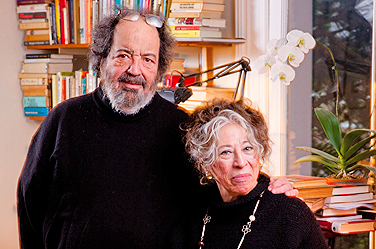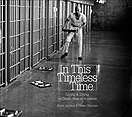News
Love of music sparks interest in prisons

Bruce Jackson and Diane Christian have collaborated on several books and a documentary film on prison culture. Photo: DOUGLAS LEVERE
-
 Print
Print -
 Comments
Comments
-

“In This Timeless Time,” the latest book by UB faculty members Bruce Jackson and Diane Christian, expands on stories in “Death Row,” a volume authored by the couple in 1979. Read the story.
Bruce Jackson’s interests in prison culture began, surprisingly, with his love for music.
A blues singer and guitarist, Jackson, SUNY Distinguished Professor and James Agee Professor of American Culture in the UB Department of English, travelled to prisons as a young man to learn new songs. After several visits, he began to find the unusual society fascinating. He produced the 1966 film “Afro-American Work Songs in a Texas Prison” with Pete and Toshi Seeger, and wrote “Wake up Dead Man,” a 1972 study of black convict work songs in Texas prisons. He also produced a number of LPs and CDs based on that fieldwork, one of which earned him a Grammy nomination.
Jackson stopped performing after he heard a large group of prisoners sing while hard at work cutting down trees by the Brazos River in Texas.
“I knew I had no more business singing those songs than I had flying to the moon without a rocket ship,” he says, “but by then I was hooked on the world.”
Jackson’s extensive research and published work on prison culture provided him and his wife and collaborator, Diane Christian, SUNY Distinguished Teaching Professor in the UB English department, entry to the O.B. Ellis Unit, a Texas Department of Criminal Justice prison in Walker County, Texas, during Holy Week in 1979.
Their work documenting in photographs and stories the world of death row inmates at the Ellis unit was published in the 1980 book “Death Row.” Their latest book, “In This Timeless Time: Living and Dying on Death Row in America,” which has just been published by University of North Carolina Press in association with the Center of Documentary Studies at Duke University, continues and expands on the stories in “Death Row.”
Back in 1979, inmates and guards at Ellis, having read some of Jackson’s earlier work, considered him a trustworthy figure and were comfortable conversing with him.
Jackson and Christian even became part of the culture, as many inmates began to rate one another according to who was interviewed the longest.
Christian believes that the fact that she and Jackson were married authenticated them and had an impact on the willingness of prisoners to accept them.
“Whether people trust you or not is extremely important,” she says, “and for whatever reason, the men thought we would tell our own story of their lives and not just repeat what they referred to as ‘the Man’s story.’”
Christian first was led to her studies of prison culture as a religious educational mission. She taught catechism in a prison for young violent offenders while in college. After college, she joined a religious order for almost eight years.
When she came to UB and married Jackson, she joined him in work at an Arkansas prison, where she taught and conducted interviews in its women’s unit. She was struck by some of the similarities in convent and prison culture, and was interested in both documenting the reality of death row and exploring the religious elements in views on violence. The courses she teaches on the Bible as literature; heaven, hell and judgment; mythology; and documentary film always look to these issues, she says.
Jackson and Christian’s work in this field has garnered critical acclaim. Their 1979 documentary “Death Row,” for instance, was used by former French President Francois Mitterrand during his campaign in the 1980s to rid France of the death penalty. It also has been used by Amnesty International to make a similar point. It has been broadcast by public television stations in the U.S., France and Germany, and exhibited at the Museum of Modern Art and other institutions.
Brent Bullock Jr., one of the investigators involved in the notorious Gary Gilmore case in Provo, Utah, saw the film at its Texas premiere. Bullock told Jackson and Christian that he had witnessed Gilmore’s execution in 1977 and was happy to do so until he saw their film, which upset him and changed his opinion of the conditions death row prisoners are forced to endure.
“He told us that our film upset him far more than seeing an actual execution,” says Jackson, “because he said that there is no excuse for doing that to human beings.”
With the publication of “In This Timeless Time,” the authors already are hard at work on their next books.
Jackson is preparing a book of photographs of Texas and Arkansas prisons called “Inside the Wire” for release in April 2013 by Texas University Press, as well as a book of his landscape, portrait and prison photographs that will serve as the catalog for a retrospective planned for next spring at Buffalo’s Burchfield Penny Art Center.
Christian, who has published extensively on issues of violence, is finishing a book of essays on these issues titled “The Priesthood of Death.”

Reader Comments